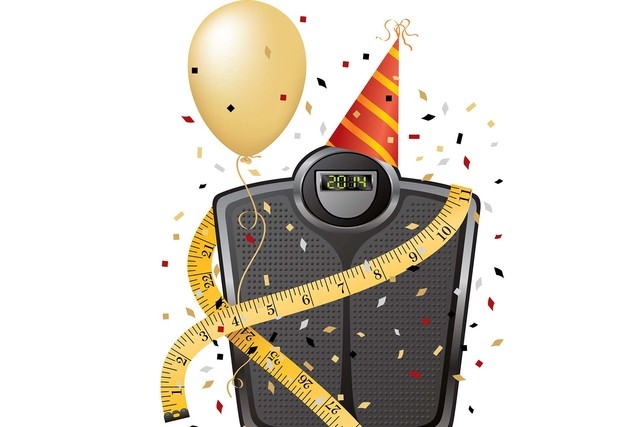Revamp your resolutions: Easy-to-follow advice will help you stay on track

It’s Jan. 2, and 2014 is just one day old.
So how are those New Year’s resolutions working out?
You know. Joining the gym. Paying off those credit card bills. Unloading a yearlong load of accumulated stress like Christmas morning’s wrapping paper?
Broken? All of ’em? Already?
Yeah. Us, too.
But 2014 is still just a screaming infant, metaphorically speaking, and there’s still time for us to work up a “Resolutions 2.0” list. And this time, we’re going to ignore all of those unrealistic, overly broad resolutions we made the first time around — seriously, how would we ever find time to get to the gym? — and, instead, focus on a few simple, easy-to-remember and easy-to-do things that’ll actually fit into our daily lives.
For help, we asked a few local experts for a bit of advice. If you follow their suggestions — and, seriously, you can — you’re sure to end 2014 a bit healthier, a bit wealthier and a bit less stressed-out than you are today.
RESOLUTION REVAMP NO. 1: EAT BETTER, LOSE WEIGHT
Both are common resolutions and worthwhile, says Joanna Gorman, a registered dietitian and certified diabetes educator at University Medical Center.
Problem is, they’re both pretty broad, pretty mushy and pretty overwhelming to accomplish. So forget the weight-loss books, the obsession with counting calories and the rigid diet programs.
Instead, buy a scale. A good one can be had for $10 or $15, Gorman says, and each day, first thing in the morning, get on that scale and see how much you weigh.
But here’s the thing: Don’t fret over a pound or two gained or lost from day to day. Instead, Gorman says, use your daily weigh-in to detect trends. If you notice that your weight is trending upward, it’s time to take action. If you notice that it’s skewing lower, congratulate yourself and keep it up.
This way, you can deal with problems before they spiral out of control. Gorman notes that many of her clients don’t even realize that they have gained weight until they’re 8, 9 or 10 pounds over what they should be. Stopping the trend at 5 pounds is more manageable.
Now, to get those numbers where you want them to be, resolve to make better food choices during 2014. Begin, Gorman says, by simply eating one fruit and one vegetable every day. A banana purchased at a convenience store. A carrot munched on at lunch. A microwaved bag of something or other (but avoid canned veggies, Gorman adds, because they tend to be high in sodium).
“I ask people, ‘How many fruits and vegetables did you have yesterday?’ and the No. 1 answer I get, usually, is ‘zero,’ ” she says.
After adding one fruit and vegetable a day, people may discover it’s not that difficult and work up to the multiple recommended daily servings of each.
Finally, begin to take better control of everyday dining choices. Try, Gorman suggests, reducing your portion sizes a smidgen — some people find that dining off of smaller plates helps — avoiding fried foods and fast foods, and making simple lower-calorie substitutions for sugary, high-calorie sodas and juices.
Gorman notes that cutting just 100 calories a day out of your diet will mean 10 pounds lost a year from now.
RESOLUTION REVAMP 2: REDUCE STRESS
“The No. 1 issue I work with the most is overstressed people or people who are not managing stress,” says Donna Wilburn, a licensed marriage and family therapist.
Stress can affect one’s health, one’s job and one’s family relationships, she says. And, certainly, signing up for a yoga or meditation class is one way of trying to reduce stress during the coming year.
But here’s a simple option: Set aside 15 minutes each day to consciously relax.
Wilburn says guided imagery programs can be found for free on YouTube, and guided imagery apps also are available for smartphones. The systematic instructions found in such programs — to imagine yourself on a beach, to breathe deeply, to let your muscles relax — can put one into “a very healthy, relaxed state,” Wilburn says, “and now you can address those things like kids and work.”
As an alternative, find a quiet spot — a bathroom with the door closed, for instance — close your eyes and just breathe, rhythmically, slowly and deeply, for 15 minutes.
Wilburn says some of her clients protest that they don’t have time to take advantage of a stress-reduction break each day. But doing so will allow for greater productivity and focus, while a stressed-out brain, in contrast, “can be distracted, disorganized and frustrated.”
RESOLUTION REVAMP NO. 3: EXERCISE MORE
Purchase a gym membership and burn up the treadmill if that’s what works for you. But Sharon Jalene, a lecturer in the University of Nevada, Las Vegas’ Department of Kinesiology and Nutrition Sciences, notes that even a moderate increase in daily physical activity can bring about major health benefits.
So: Walk just a bit more each day.
Begin by walking 2,000 more steps every day. Jalene says the average person walks about 5,000 steps a day, and adding 2,000 could translate to a loss of about 8 pounds over a year’s time.
So take the stairs instead of the elevator. Park farther away from the mall entrance. Take a stroll around the block, or around the parking lot at work during your lunch hour.
Or, walk the dog twice a day. Jalene notes that, because dog owners tend to be more physically active than nonowners, “one of the best things you can do is buy a dog.”
You don’t even have to walk the extra 2,000 steps all at once. “They can be broken into intervals of five minutes at a time,” Jalene says.
Some walkers find that wearing a pedometer provides an incentive to track and then increase their daily step total. If you’re a gadget fan, similar devices can connect with smartphones or laptops and allow walkers to share their step totals with one another. Walking with, or competing with, others can make walking fun.
Eventually, you may feel moved to increase your step count to 10,000 each day, which would offer greater protection against cardiovascular problems and even some cancers, Jalene says.
“Walking is brilliant,” Jalene says. “There is a lot of good research that says walking 150 minutes a week will help to decrease massive health risks.”
The trick to keeping a resolution to exercise comes down to finding a physical activity that you enjoy, Jalene adds. “A lot of people think ‘exercising’ means going to the gym and getting on a treadmill. But maybe you hate the treadmill, so it’s not going to be successful for you.
“So find something you enjoy. Maybe you enjoy dancing to AC/DC in the living room, or going to Zumba class. Make it social. Play with the kids in the park. Sometimes we don’t even think of things as being exercise, but they are, in fact, movement, and we are designed to move.”
RESOLUTION REVAMP NO. 4: FIX THE FINANCES
Here’s the thing: It took you a while to get into debt or to create (or not start) that anemic retirement account, so don’t expect to completely resolve things over the course of, even, a full year.
But you can start in 2014.
Begin by tackling your credit card debt, says Deborah Danielson, a certified financial planner and owner of Danielson Financial Group.
Consumers often “pay the minimum payment and they’re going nowhere,” she says. “So you just need to make a resolution to add to it and to keep paying down more than the minimum.”
How to free up a few extra bucks to do that? Start by simply taking a look at where your money is going right now.
“It’s a few less Starbucks, a few less pizzas and takeout and maybe cooking at home a little more often,” Danielson says. “It’s maybe nixing some of your entertainment and doing some movies at home.”
One simple change: Brown bag it to work. That $8 a day not spent on fast-food lunches will give you close to $2,000 a year from now that could be redirected toward your credit card debt.
Or, Danielson says, find a part-time job and devote all of the money you earn to your debt.
“Those are simple things that give you extra money,” Danielson says.
Also take a look at expenses you may not even realize you’re paying. For example, look at your cable TV package and your cellphone plan to see if the features you’re paying for are worth it.
So now that your simple efforts are saving a few bucks, and you’re putting extra money toward retiring your credit debt, don’t forget to invest for your future, too.
A key, but easily made, change: “If you have a 401(k) match at work, figure out ways to at least put aside enough to earn the match,” Danielson says.
A 401(k) match is “free money,” she adds.
Sign up for automatic payroll deductions that will direct money directly into retirement accounts and, if you’re saving for the kids’ education, college accounts. “That way you set yourself up to win, not to fail,” Danielson says.
RESOLUTION NO. 5: BE MORE HEALTHY
Most of us tend to deal with medical or health issues as they arise. But New Year’s is a great time to get a few simple things in order for the coming year.
First, says Dr. Mitchell Forman, dean of Touro University Nevada College of Osteopathic Medicine, take a look at heath-related issues that arose during the past year and make sure your medical insurance is adequate for things that may come up this year.
Address health issues that may be ongoing, Forman says. Schedule any necessary follow-up visits or procedures.
“This includes things like immunizations, screenings and tests that need to be done,” Forman says. “And part of that, too, is making the necessary appointments for dental care.”
Survey your medicine cabinet to make sure everything’s current and that the cabinet is secured from children, Forman says. While you’re at it, make a list of medications you take, including dosages for each, and keep it in your wallet just in case.
Finally, Forman says, remember that moderation is a good prescription for just about anything.
RESOLUTION REVAMP NO. 6: BECOME MORE SPIRITUAL, WHATEVER THAT MEANS TO YOU
For Rabbi Yocheved Mintz of Congregation P’nai Tikvah and other members of the valley’s Jewish community, the new year — the year 5774, to be exact — arrived in September with Rosh Hashana.
Still, Mintz says, “for many of us living in a secular world, we get a wake-up call about this time of year to remind us to put ourselves back on track.”
Whatever the faith tradition, resolving to reconnect to and strengthen one’s spirituality often can begin with simply reminding ourselves to be thankful, Mintz says.
In Judaism, one prayer that is to be offered before getting out of bed gives “thanks to God for returning our souls to us,” Mintz notes.
“But the clincher of this particular prayer is the way it ends. It’s: ‘How great is Your faith,’ and ‘your” with a capital Y. Not ‘How great is my faith in You, but how great is Your faith in me,’ which reminds us that God has faith that we have potential. So it’s up to us to begin this day to work toward that potential.”
“Starting the day with an attitude of gratitude,” Mintz says, is “a good and simple way” of incorporating into our daily lives “the strength that the spiritual life can give us.”
Contact reporter John Przybys at jprzybys@reviewjournal.com or 702-383-0280.


















